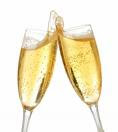- Step 1
LOOK
* Pour a nice Pinot Noir or Sauvignon Blanc into a simple glass that curves inward (about a third full). Holding the glass by the stem, tip it against a white background (sheet of paper).
Examine the wine:
* Is it clear or cloudy? This can tell you if the wine has a fault or not
* What colour is it?
* White wines: white-lemon-gold
* Red Wines: purple, ruby, tawny
* Rose Wines: pink, rose or orange
* Compare the colour at the centre of the glass with the colour at the rim.
*What can the colour tell you?
White Wines:
become deeper (more yellow/golden) with age.
Red Wines: the more purple the wine, the younger it is. In young wines, the colour is usually uniform. The more brown, tawny or orange the wine, the older it is. With age, the colour is not uniform and is lighter at the rim of the glass compared with the centre.
Generally, the lighter the colour of the wine, the cooler the climate.However, certain grape varieties are characteristically lighter or darker in colour. - Step 2
SMELL
* Swirl the wine in the glass to increase the surface area exposure to the air. This helps it develop.
* Take a quick sniff (remember, first impressions count the most)
* Does it smell clean or unclean?
This can tell you if the wine is corked or not. If corked, it will have a musty smell.
* Does it smell weak or intense?
This can tell you about the wine's origin. The more intense the nose, the more likely that the grapes were grown in a hot climate and the level of sugar and therefore alcohol is higher.
* What does it smell of?
Fruity, Savoury, Dairy, Nutty, Spicy, Mineral, Sugary, Woody, Floral, Herbal.
*What can the smell tell you?
Older wines tend to smell more savoury and spicy and less of fruit.
Younger wines tend to smell more of fruit. However, some grape varieties have very distinctive bouquets. - Step 3
TASTE
* Take a mouthful of wine (not too much) and swirl it around your mouth (so every taste bud gets a chance to taste it).
* Professional tasters draw in air at the same time to increase the contact with air and give the wine a chance to evolve in the mouth.
* Spit it out (optional, unless you've got 15 or more wines to taste!).
* Can you taste the sweetness?
Sweetness is tasted at the tip of the tongue. It tastes sugary. It comes from the sugar in ripe grapes that is left after fermentation has finished. Is the wine dry, medium or sweet?
* Can you taste the acidity?
Acidity is tasted on the sides of the tongue and tastes like lemons. It occurs naturally in grapes and is important to balance sweetness. White wines have more acidity than red wines. Does the wine have low, medium or high levels of acidity?
* Can you taste the tannin?
Tannin is tasted on the teeth and gums and tastes bitter like a strong cup of tea that makes your mouth 'fur' up. It also has the sensation of an under-ripe or green banana. Tannin comes from the skins of the grapes and from oak ageing. It is mainly found in red wines. What flavours can you taste? Fruity, Savoury, Dairy, Nutty, Spicy, Mineral, Sugary, Woody, Floral, Herbal
* Are the flavours weak or pronounced?
* Can you feel the alcohol?
Alcohol is sensed at the back of the throat and gives a warming sensation. The higher the level of sugar in the grapes before fermentation, the higher potential alcohol the wine will have, i.e. hotter countries tend to produce wines higher in alcohol. Are there low, medium or high levels of alcohol? You can also see this from the 'legs' left on the sides of the glass. This is also an indication of sweetness.
* How 'long' is the wine?
This is a term that describes the length of time you can taste the wine once you have swallowed (or spat it out!). Is the length, short, medium or long? It gives an indication of quality. The longer the length, the higher the quality. - Step 4
* What can the taste tell you?
* Quality:
* A good sign of quality is balance. A wine is balanced when all of the wine's components (eg. sweetness, acidity, tannins) blend together. The balance or potential to be balanced after ageing is a sign of quality.
* Maturity:
* Older red wines tend to taste more savoury and spicy. Older white wines tend to taste more honeyed and yeasty. Younger wines tend to taste more of fruit.Origin: Hotter countries mean riper grapes and more overtly fruity wines (and a higher degree of alcohol).
* Grape Variety:
* Certain grape varieties taste of certain flavours, e.g. Sauvignon Blanc typically tastes and smells of gooseberries, Pinot Noir of red fruit and minerals.
Wednesday, 14 October 2009
Wine Tastings - as the experts do it!
Subscribe to:
Comments (Atom)

